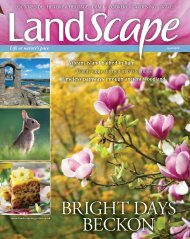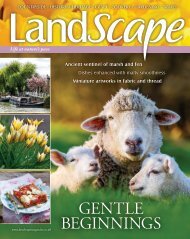You also want an ePaper? Increase the reach of your titles
YUMPU automatically turns print PDFs into web optimized ePapers that Google loves.
STILL ONLY £1.99! PLUS FREE SEEDS<br />
April 8, 2017<br />
worth<br />
£2.99!<br />
5<br />
Veg you can get in<br />
the ground right now!<br />
Britain's<br />
most trusted<br />
voice in<br />
gardening<br />
Carol<br />
Klein<br />
'Why growing<br />
from seed is<br />
a highlight<br />
of the year'<br />
FREE SEEDS<br />
£2.99!<br />
worth<br />
Create the<br />
ultimate<br />
compost<br />
Primulas<br />
to give you<br />
a rainbow<br />
of colour<br />
JOBS TO DO NOW<br />
✔ Sow flowers<br />
for cutting<br />
✔ Spruce up<br />
your patio<br />
containers<br />
✔ Grow<br />
pumpkins<br />
Help your garden<br />
thrive!<br />
l Fill your plot with wildlife<br />
l Spring guide to plant feeding<br />
l Tackle those pesky pests<br />
IT'S Time to take<br />
dahlia cuttings
P.18<br />
Add colour with<br />
pelargoniums<br />
Spring comes<br />
in like a lion<br />
Well, Storm Doris certainly left her<br />
mark. At first I thought she was<br />
going to blow through with barely<br />
a whimper – from the safety of my<br />
desk all seemed quite calm outside!<br />
Then, as I sipped contentedly on my<br />
coffee, my wife called to say our fence<br />
was no more! And she didn’t stop<br />
there (Doris, not my wife): pots were<br />
blown over and smashed, an apple tree<br />
ravaged and the wheelie bin upended<br />
and emptied. Since then, some parts of<br />
the country have battled Storm Ewan<br />
too – I hope not too much damage was<br />
done. Still, <strong>Garden</strong> <strong>News</strong> readers are<br />
nothing if not determined<br />
and I know you’ll have been<br />
busy putting things right.<br />
It takes more than Doris<br />
and Ewan to stop us!<br />
<strong>Garden</strong> <strong>News</strong><br />
Editor<br />
Britain’s most trusted<br />
voice in gardening<br />
P.32<br />
Plant bare-root<br />
perennials now<br />
Our cover star:<br />
Narcissus ‘Tahiti’<br />
P.14<br />
Six steps to a<br />
lovely lawn<br />
P.31<br />
Celebrate<br />
spring in a pot<br />
We love this delightful, double-flowered<br />
daff, with its large, golden segments which<br />
nestle around smaller, rich-orange ruffled<br />
ones. Find out which varieties bulb expert<br />
Johnny Walkers favours on page 49.<br />
Alamy Neil Hepworth Neil Hepworth<br />
Alamy<br />
Subscribe today<br />
& GET EACH ISSUE FOR<br />
JUST £1<br />
Go to www.greatmagazines.co.uk/gn<br />
Look inside!<br />
About Now<br />
4 <strong>News</strong> from the gardening world<br />
5 Plant of the Week: Geum<br />
6 Hand weeders are tested<br />
7 My Life in Plants<br />
9 Very Important Plant<br />
10 Top 5... spring-flowering<br />
wall shrubs<br />
P.5<br />
12 Wildlife<br />
Features<br />
14 Get a pristine lawn<br />
18 Perfect pelargoniums<br />
20 <strong>Garden</strong> of the Week<br />
24 Colour up with grasses<br />
28 Carol Klein explains why trees<br />
are our good friends<br />
57 Homegrown: Purple-sprouting<br />
broccoli<br />
What To Do This Week<br />
31 Create spring in a container<br />
32 Plant bare-root perennials<br />
35 Nick Bailey inspires us to<br />
reinvent trees and shrubs<br />
37 Martin Fish is tidying up<br />
his streptocarpus<br />
38 Pop in your peas!<br />
39 Medwyn Williams hedges his<br />
bets when sowing celery<br />
41 The allotment is coming to life<br />
for Terry Walton<br />
The Experts<br />
45 Tony Dickerson problem solves<br />
48 Plan for a dazzling daff display<br />
49 How to get chrysanths set up<br />
for the season<br />
You and Your <strong>Garden</strong>s<br />
50 Readers’ gardens<br />
53 Your letters and photos<br />
66 <strong>Garden</strong>ing Genius<br />
Offers & Competitions<br />
55 Prize-winning crossword<br />
59 Buy an apple tree collection<br />
61 Super savings on sweet peas<br />
62 Free lily and arisaema bulbs<br />
Get in touch!<br />
Email gn.letters@bauermedia.co.uk<br />
Facebook facebook.com/<br />
<strong>Garden</strong><strong>News</strong>Official<br />
Twitter twitter.com/<strong>Garden</strong><strong>News</strong>Mag<br />
Write to Simon Caney, <strong>Garden</strong> <strong>News</strong>,<br />
Media House, Peterborough Business<br />
Park, Lynch Wood, Peterborough PE2 6EA<br />
March 11 2017 / <strong>Garden</strong> <strong>News</strong> 3
Plant<br />
of the<br />
week<br />
Spring<br />
spurges!<br />
Best for dazzling displays<br />
Their luminous yellow tones make<br />
the ideal foil for bright early bulbs<br />
Among the rush of spring<br />
perennials, euphorbias – or<br />
spurges as they’re<br />
commonly called – are often the<br />
most distinctive and readily<br />
identifiable. They produce their<br />
heads of acid yellow, hooded or<br />
disc-like ‘flowers’ (really coloured<br />
bracts) in dense heads on stems<br />
clothed in blue-green leaves.<br />
It’s a huge group of plants<br />
coming from a variety of habitats<br />
from sunny, Mediterranean<br />
climates and shady woodland to<br />
moist meadows, so there are types<br />
for all sites and situations. Habits<br />
vary too, from ground-hugging,<br />
creeping mats, to stout, upright<br />
clumps in the larger varieties of<br />
species such as E. characias, that<br />
grow up to 1.8m (6ft).<br />
Flowering periods span spring<br />
through to high summer, but it’s<br />
in spring where they help make<br />
the most dramatic impact. The<br />
luminous yellow tones of the<br />
long-lasting flowers are an ideal<br />
foil for the bright blossoms of<br />
late-spring bulbs such as tulips<br />
or camassias, or early perennials<br />
such as geum and anemones.<br />
The flower-bracts often persist<br />
into autumn to add further<br />
texture, when many of the<br />
deciduous species and varieties,<br />
such as E. palustris, also assume<br />
orange and yellow tints.<br />
Leaves can also be brightly<br />
coloured, either through white,<br />
cream or red variegation, which is<br />
at its strongest and most potent in<br />
new spring growth. The young<br />
shoots of some spurges, such as<br />
‘Excalibur’ are also strongly<br />
tinted in red, orange, purple or<br />
bronze tones as they push through<br />
the ground, the effect fading as<br />
they grow and age.<br />
Remove the older flowering<br />
stems of evergreen species such<br />
as E. characias in autumn as<br />
more will form each year. Cut the<br />
deciduous species back to ground<br />
level at the back end of the year.<br />
All parts of the plant exude a white, sticky<br />
sap when damaged, which can be an irritant,<br />
so always wear gloves when handling<br />
E. characias<br />
‘Tasmanian Tiger’<br />
An evergreen, variegated<br />
form that grows best in a<br />
sheltered spot. H: 90cm (3ft).<br />
E. cyparissias<br />
‘Fens Ruby’<br />
This low, wide-spreading<br />
variety tints purple in full<br />
sun. H: 30cm (12in).<br />
E. characias<br />
‘Humpty Dumpty’<br />
Being compact and clumpforming,<br />
it’s ideal for small<br />
gardens. H&S: 60cm (2ft).<br />
E. ‘Excalibur’<br />
This upright, deciduous<br />
form has wine-tinted leaves<br />
in spring and yellow flowers<br />
in June. H: 90cm (3ft).<br />
E. epithymoides<br />
A short, early-flowering<br />
herbaceous species,<br />
producing yellow flowers<br />
in April. H&S: 50cm (18in).<br />
E. palustris<br />
An adaptable and robust,<br />
deciduous species with bright<br />
yellow flowers in April and<br />
May. H&S: 90cm (3ft).<br />
All photos: Alamy<br />
Subscribe for just £1 an issue. Go to www.greatmagazines.co.uk/gn<br />
March 18 2017 / <strong>Garden</strong> <strong>News</strong> 5
CAROL KLEIN<br />
This week<br />
AT GLEBE<br />
COTTAGE<br />
“What you plant with them<br />
has a direct effect on their<br />
health. In nature, wild roses<br />
grow among herbaceous<br />
plants and grasses”<br />
Getting the most<br />
from roses<br />
They’re a must-have flower for many gardens<br />
– and will respond magnificently to the right care<br />
Everyone loves roses!<br />
They’ve won countless<br />
polls as ‘The Nation’s<br />
Favourite Flower’ and even<br />
non-gardeners seem to be<br />
enamoured by them. Of all the<br />
world’s flowers, they must be<br />
the most instantly recognisable<br />
and they’ve the longest links<br />
with human society, having<br />
been honoured and revered by<br />
all the ancient civilisations.<br />
Nowadays, they’re not only<br />
still given as love tokens, but<br />
are an important addition to<br />
many gardens. But how do<br />
we get the best out of them?<br />
First and foremost, choose<br />
an open site that gets plenty of<br />
sunshine (when it’s available).<br />
Although roses are<br />
accommodating plants, they<br />
love sun and will always flower<br />
more profusely in full light than<br />
they would in dappled shade.<br />
Like most plants, roses need<br />
good soil. If you’re planting new<br />
roses make sure you add loads<br />
of organic matter to the soil.<br />
Home-made compost is the best<br />
bet, but there are also proprietary<br />
products you can use.<br />
In the first year after planting,<br />
whether it’s from bare-root or<br />
container-grown plants, roses<br />
concentrate on making roots, so<br />
soil preparation is all-important<br />
to ensure the formation of a<br />
strong root system and lots of<br />
fine, fibrous feeding roots. That’s<br />
not the end of the story: roses<br />
need continuous sustenance as<br />
Feed roses with compost<br />
to keep them growing<br />
and flowering strongly<br />
they grow if they’re to thrive.<br />
Mulching with compost is one<br />
of the best ways to feed roses.<br />
Not only does it suppress weeds,<br />
cutting down competition,<br />
but it also keeps the soil moist<br />
and, most importantly, tops up<br />
the nutrients the rose needs.<br />
What you plant with your<br />
30 <strong>Garden</strong> <strong>News</strong> / March 25 2017
Photos: Jonathan Buckley<br />
roses has a direct effect on their<br />
health. In nature, wild roses<br />
grow among herbaceous plants<br />
and grasses, but in the 1950s’<br />
traditional rose garden there<br />
would have been nothing but<br />
roses – a veritable mono-culture<br />
that encouraged disease.<br />
In the outstanding Walled<br />
Rose <strong>Garden</strong> at Mottisfont<br />
Abbey, designed by one of the<br />
greatest rosarians ever, Graham<br />
Stuart Thomas, more than 500<br />
varieties of mainly ‘old’ roses<br />
are planted in borders full of<br />
perennial flowers. Not only does<br />
this provide an ongoing pageant<br />
from May until the frosts, but<br />
it keeps the roses happy and<br />
healthy. I find it soul-destroying<br />
to see bare stemmed roses<br />
surrounded by bare soil, which<br />
used to be such a common<br />
sight in front garden rose beds<br />
up and down the country.<br />
As well as giving them the<br />
right company, they need<br />
water and decent drainage.<br />
If roses are planted well and<br />
mulched properly, once they’re<br />
There are some woodland<br />
wonders, mainly from<br />
North America, that have<br />
a habit of diving under the<br />
soil when they’ve finished<br />
flowering. Because they’re<br />
dormant for such a long<br />
time, they’re sometimes<br />
forgotten and occasionally<br />
dug up by mistake. I should<br />
label them more carefully,<br />
they’re such treasures you<br />
just don’t want to lose them.<br />
They all cope well with<br />
shade. Blood root, Sanguinaria<br />
canadensis is a good<br />
example. The whole<br />
plant, including the thick,<br />
spreading rootstock which<br />
bleeds red sap when<br />
damaged, is succulent<br />
and fleshy. Each emerging<br />
flower bud is wrapped<br />
tightly in one scalloped<br />
leaf, which unfurls as<br />
the flower stem pushes<br />
up its fragile flower.<br />
The simple, pure white<br />
flowers are fleeting,<br />
almost ghostly in<br />
their transparency,<br />
seldom lasting more<br />
than a day or two – a<br />
established they shouldn’t need<br />
frequent watering. In fact, it’s<br />
important not to overwater<br />
them – if the roots have to<br />
strive for water, they’ll become<br />
stronger and venture further<br />
afield. Nonetheless, they may<br />
need help in times of drought.<br />
Pruning’s not a mystery. The<br />
same common-sense rules apply<br />
as they would when pruning<br />
any woody shrub. With old<br />
roses, some experts advocate a<br />
little-or-nothing approach when<br />
it comes to pruning, but I find<br />
some old roses dwindle when<br />
left to their own devices, so most<br />
of ours get pruned regularly.<br />
Removing the three Ds<br />
– dead, diseased and damaged<br />
wood – is imperative, after<br />
which the objective is to<br />
encourage the rose to make<br />
an open shape so branches<br />
don’t get crossed and so air<br />
circulates easily. The aim<br />
is always to encourage the<br />
formation of wood that will<br />
produce flowers. After all,<br />
that’s why we grow them!<br />
What’s looking good this week<br />
Woodland treasure<br />
mere nuance of a flower.<br />
More often cultivated, the<br />
double form, Sanguinaria<br />
canadensis multiplex ‘Plena’,<br />
is less graceful, but much<br />
longer-lasting. Its chunky,<br />
globose flowers are composed<br />
of layers of pristine petals.<br />
Once seen, never forgotten.<br />
This is an ‘ooh-aah, can’t live<br />
without it, absolutely musthave’<br />
plant. It prefers leafy,<br />
acid soil, but alas, even when<br />
conditions seem perfect, it<br />
sometimes disappears.<br />
The must-have<br />
plant, doubleflowered<br />
blood root<br />
My gardening Diary<br />
MONDAY Planting in<br />
earnest to try and make<br />
sure everything’s in the<br />
ground before the<br />
weather warms up too<br />
much. Plants always<br />
seem to acclimatise<br />
better when planted<br />
before they take off.<br />
One of the most<br />
pressing priorities is<br />
Polemonium yezoense,<br />
grown from seed.<br />
Lovely plants but<br />
there are 60 or more<br />
to plant out!<br />
TUESDAY Primroses have come on apace after a<br />
slow start. The ones we divided last year are flowering<br />
well and a seed tray where I sowed Primula vulgaris<br />
last year has suddenly greened up with scores of tiny<br />
plants – unmistakably primroses. To think I almost<br />
abandoned it!<br />
WEDNESDAY We used to have two pulmonarias that<br />
‘made’ themselves in the garden here at Glebe. The one<br />
with opal-white flowers we called ‘Moonstone’ and,<br />
very predictably, the one with blue flowers ‘Glebe<br />
Cottage Blue’. I thought they were lost, but I’ve just<br />
found one plant of each. Since you can grow more from<br />
root cuttings, there’s no reason to lose them again.<br />
THURSDAY Topping up lily pots. The bulbs were<br />
planted quite deeply and were only just covered with<br />
loam-based compost. As soon as we see new shoots<br />
emerging, we add a few inches of compost. We’ll<br />
continue to add more as the shoots grow taller. This<br />
helps make strong stems and, hopefully, good flowers.<br />
FRIDAY Some of the mixed salad leaves we’ve sown<br />
are doing well, but we’ll leave them in their seed trays<br />
and use them as cut-and-come-again. We’re sowing<br />
more to eventually prick out and plant out. They<br />
germinate so readily, there’s no excuse for me not to<br />
provide fresh leaves all the time.<br />
SATURDAY One of our next little films for <strong>Garden</strong>ers’<br />
World is about the primrose. I’ve been re-reading<br />
Florence Bellis’ book <strong>Garden</strong>ing and Beyond. She was<br />
the American woman who originally bred the<br />
Barnhaven strains of primulas. Her writing is informative<br />
and witty, too!<br />
SUNDAY Erythroniums are a special love and we were<br />
lucky enough to buy some interesting varieties from<br />
Wildside Nursery a couple of years ago. They were kept<br />
in their pots too long – the bulbs try to<br />
escape through the drainage holes – but<br />
we planted them in our raised beds and<br />
they’re just coming up, their marbled<br />
leaves pushing through, wrapped<br />
around flower buds.<br />
Carol Klein<br />
Sowing Primula<br />
vulgaris ‘in the green’<br />
Subscribe for just £1 an issue. Go to www.greatmagazines.co.uk/gn
Alamy<br />
TONY DICKERSON<br />
The Problem<br />
SOLVER<br />
Royal Horticultural Society gardening advisor and podcaster<br />
How should I grow<br />
bulbs in containers?<br />
QI want to grow summerflowering<br />
bulbs in pots.<br />
How do I go about it?<br />
Sarah Lord, Stareton,<br />
Warwickshire<br />
AThere’s a wide range of<br />
summer-flowering bulbs or<br />
bulb-like plants in garden centres<br />
to plant now. Many are tender,<br />
so are well-suited to containers.<br />
My default potting compost mix<br />
tends to be equal quantities of<br />
John Innes (No 2 or 3 is fine),<br />
multi-purpose and sharp sand.<br />
Cannas come in<br />
a spectrum of<br />
striking colours<br />
This provides adequate nutrients<br />
to get the plants going, is welldrained,<br />
but doesn’t dry out<br />
too quickly. Nor is it too light,<br />
so pots don’t get blown over.<br />
There are a few bulbs, such as<br />
crinum, that are planted with the<br />
‘snout’ of the bulb exposed.<br />
Those that grow from rhizomes,<br />
such as cannas and ginger lilies<br />
(hedychium) should be planted<br />
horizontally and just covered<br />
with potting compost.<br />
Most true bulbs are planted<br />
three times their own depth, s<br />
o when the bulb is sat in the<br />
hole it has twice its depth of<br />
potting compost over the top.<br />
For impact, I’d space small<br />
bulbs no more than 2.5cm<br />
(1in) apart. Larger bulbs<br />
generally need to be their<br />
own width apart.<br />
On planting, water<br />
the bulbs gently in. They<br />
shouldn’t need watering<br />
again until the shoots start<br />
to show. Cannas and ginger<br />
lilies do better started in<br />
a propagator with some<br />
bottom heat. A month<br />
after the first shoots come<br />
through start liquid feeding once<br />
a week with tomato fertiliser,<br />
which is high in potassium<br />
(potash) to encourage good<br />
flowering, but not excessive leaf.<br />
In hot weather take care the pots<br />
don’t dry out. Once flowering<br />
starts, deadhead regularly.<br />
After flowering, reduce<br />
Many summerflowering<br />
bulbs have a<br />
tropical look<br />
and grow well<br />
in containers<br />
feeding to once a fortnight and<br />
continue watering until the<br />
foliage starts to yellow. At that<br />
point, stop watering and allow<br />
the foliage to die back. I find it<br />
easiest to overwinter bulbs in<br />
their pots. More tender types will<br />
need the protection of a<br />
greenhouse or conservatory.<br />
GWI<br />
Four top summer-flowering bulbs<br />
Shutterstock<br />
Shutterstock<br />
Shutterstock<br />
Shutterstock<br />
Gladioli<br />
Plant gladioli 20cm (8in)<br />
deep in containers. They’re<br />
very easy to grow and make<br />
gorgeous cut flowers.<br />
Eucomis<br />
Unusual-looking eucomis, or<br />
pineapple lily, isn’t fully hardy<br />
so keep it in a sheltered, but<br />
sunny spot.<br />
Subscribe for just £1 an issue. Go to www.greatmagazines.co.uk/gn<br />
Crocosmia<br />
Crocosmia is easy to grow,<br />
flowering from mid to late<br />
summer in bright shades of<br />
red, orange and yellow.<br />
Freesia<br />
Freesias aren’t difficult, just<br />
make sure you buy prepared<br />
corms. These have been heattreated<br />
to break dormancy.<br />
Continues over the page<br />
March 25 2017 / <strong>Garden</strong> <strong>News</strong> 45
The Problem SOLVER<br />
QWill cutting hedges in<br />
spring and summer<br />
disturb nesting birds?<br />
Frank Morton,<br />
Evesham, Worcestershire<br />
AIdeally, any cutting or<br />
removal of hedges should<br />
be undertaken during the<br />
autumn or winter to avoid<br />
disturbance to birds during<br />
the breeding season, but this<br />
isn’t the best time to clip<br />
evergreen shrubs.<br />
It’s an offence under the<br />
Wildlife and Countryside Act<br />
Check there are<br />
no birds nesting<br />
in your hedge<br />
before cutting<br />
Bonfire ash<br />
is beneficial<br />
to brassicas<br />
1981 to disturb birds when<br />
they’re using or building a nest,<br />
or to intentionally damage their<br />
nests. It’s generally accepted that<br />
March 1 to August 31 is the<br />
standard bird breeding season,<br />
and the RSPB recommends using<br />
these dates as a guide for the<br />
period to avoid cutting hedges<br />
and trees. The legislation appears<br />
to imply that an offence is only<br />
committed if nesting birds are<br />
present, so carefully check the<br />
hedge out and, if you’re<br />
confident none are present,<br />
you can go ahead.<br />
Shutterstock<br />
QCan I grow veg on a<br />
former bonfire site?<br />
Lilian Morris, by email<br />
AIt depends on<br />
what has been<br />
burned there. If it’s<br />
just garden clippings<br />
and prunings it’ll be<br />
fine, but the ash will be<br />
alkaline so spread it out<br />
Shutterstock<br />
Grow carrots<br />
under insect-proof<br />
netting to prevent<br />
carrot fly<br />
What’s the best<br />
fly-resistant carrot?<br />
QCan you recommend<br />
a fly-resistant carrot?<br />
Mrs Anne Vinnicombe,<br />
by email<br />
Carrot fly is a small,<br />
A black-bodied fly whose<br />
slender, creamy yellow<br />
maggots feed on the roots of<br />
carrots and related plants,<br />
such as parsnips. They cause<br />
rusty-brown tunnels in the<br />
taproots making them<br />
inedible. There are several<br />
carrots that are less<br />
and plant brassicas. Cabbages,<br />
caulis, and the like, love alkaline<br />
soil and it’ll reduce problems of<br />
club root infection. Avoid<br />
growing potatoes there as<br />
alkalinity increases the<br />
incidence of potato scab.<br />
If the site has been used to<br />
burn general rubbish, including<br />
plastics and treated timber,<br />
then you need to dispose of<br />
susceptible to carrot fly,<br />
such as ‘Fly Away’, ‘Ibiza’, ‘<br />
Maestro’, ‘Parano’, ‘Resistafly’<br />
and ‘Sytan’, but they’re not<br />
fully resistant.<br />
Crops are best protected<br />
with a physical barrier.<br />
Surrounding them with a<br />
60cm (2ft) high barrier of<br />
clear polythene to exclude the<br />
low-flying females appears to<br />
work well. I leave nothing to<br />
chance and cover my carrots<br />
from sowing to harvest with<br />
insect-proof netting.<br />
the material. Alternatively,<br />
plant up with ornamental<br />
plants, avoiding any that like<br />
acid soils, including roses.<br />
Just be aware that<br />
accumulations of bonfire<br />
ash can form a compacted<br />
layer and if there are large<br />
amounts you might want to<br />
bag it up and take it to your<br />
recycling centre for disposal.<br />
Shutterstock<br />
QHow can I protect against fuchsia gall mite?<br />
Mrs Pam Baker, Orsett, Essex<br />
AFuchsia gall mite is a microscopic, sap-sucking mite<br />
specific to fuchsias. They secrete chemicals that cause<br />
distortion of the shoots and flowers, ruining the plants.<br />
Pesticides available to home gardeners are ineffective.<br />
Cutting off infested shoot tips will remove a lot of<br />
mites, but regrowth is likely to become<br />
infested. The most susceptible species<br />
include F. arborescens, F. magellanica<br />
and F. procumbens. Less susceptible<br />
fuchias include ‘Baby Chang’,<br />
‘Cinnabarina’, ‘Miniature Jewels’<br />
and ‘Space Shuttle’. I’d generally<br />
avoid introducing any new fuchsias<br />
into your garden or greenhouse. If<br />
you do buy new ones, put them<br />
into an isolated quarantine area for<br />
several weeks to check you aren’t<br />
introducing the pest.<br />
Fuchsia magellanica<br />
is most susceptible to<br />
fuchsia gall mite (left)<br />
46 <strong>Garden</strong> <strong>News</strong> / March 25 2017<br />
Shutterstock
<strong>Garden</strong><br />
OF THE<br />
WEEK<br />
<strong>Garden</strong>er Richard and<br />
Hilary Lawrence<br />
Location 119 Scalford Road,<br />
Melton Mowbray, LE13 1JZ<br />
Been in garden 27 years<br />
Open Sunday July 30 (11am-5pm).<br />
Admission £2.50, children free.<br />
Home-made teas, including gluten<br />
free. Visitors also welcome by<br />
arrangement June to August for<br />
groups 10-25 max. Admission<br />
£2.50, children free.<br />
More info Visit www.ngs.org.uk<br />
A world in<br />
one garden<br />
This Leicestershire plot looks more than a little exotic with dramatic<br />
foliage and plant colour collected on its owners’ holiday travels<br />
Before<br />
Words Karen Murphy<br />
Photos Neil Hepworth<br />
Have you ever travelled to<br />
far-flung climes, eager to<br />
grow all those beautiful<br />
local plants back home? Well,<br />
Richard and Hilary Lawrence’s<br />
garden in Melton Mowbray is<br />
an exercise in doing just that.<br />
Their larger-than-average<br />
Leicestershire plot belies its<br />
rural middle English setting,<br />
appearing more like a little exotic<br />
botanical garden, stowed away<br />
in secret, all jungle-like foliage<br />
and dramatic plant colour.<br />
It couldn’t be more different<br />
now to how it looked when they<br />
first arrived – straight lines of<br />
bedding borders, a colossal lawn<br />
and a little herb patch – all very<br />
run-of-the-mill. After being<br />
severely reduced, the lawn<br />
has become just a supporting<br />
feature. The main stars of the<br />
show now are the large, winding<br />
borders slicing through it,<br />
teeming with exciting plants.<br />
“We try to go unusual<br />
wherever possible,” says<br />
Richard. “But while I’m more<br />
of a ‘throw everything unusual<br />
in together’ gardener, Hilary is<br />
much more methodical, so we<br />
complement each other well!”<br />
20 <strong>Garden</strong> <strong>News</strong> / March 25 2017
Left, as the garden is now,<br />
a pocket paradise in rural<br />
Leicestershire. Right, dotted<br />
dahlias mingle with<br />
aeoniums, pelargoniums<br />
and a large strawberry patch<br />
Their travels<br />
around the world have<br />
inspired them to push<br />
the boat out and grow<br />
many different plants. The<br />
rare tomato-like perennial<br />
Solanum quitoense from South<br />
America takes pride of place,<br />
enjoying warmth and shelter<br />
outdoors in summer before<br />
coming indoors for winter.<br />
Another subtropical plant<br />
from that continent – one we’ve<br />
all come to adopt as our own –<br />
is sprinkled liberally through<br />
the garden: dahlias. “Dahlias<br />
show those who may be a little<br />
apprehensive about growing<br />
exotics in the UK, that it’s okay.<br />
We’ve obviously grown them<br />
over here for centuries, so similar<br />
plants can thrive just as well,”<br />
says Richard.<br />
South African<br />
red hot pokers and crocosmia,<br />
tropical castor oil plants and<br />
even blowsy bedding favourites,<br />
begonias, are given plenty of<br />
room. Begonias, originating<br />
from the humid subtropics,<br />
and inspiringly plentiful on<br />
Richard and Hilary’s travels<br />
over there, are among his pièces<br />
de résistance during their NGS<br />
open day in late summer.<br />
He has gloriously large double<br />
blooms looking magnificent in<br />
Subscribe for just £1 an issue. Go to www.greatmagazines.co.uk/gn<br />
Left, just one of the exotic<br />
solanums, S. pyracanthum,<br />
native to Madagascar.<br />
Right, the couple grow a<br />
hefty collection of<br />
tomatoes in the greenhouse<br />
stately pots. “I always get great<br />
comments about them from<br />
visitors,” says Richard, proudly.<br />
On a recent trip to North<br />
America, their plant hunting<br />
continued. “There’s a fantastic<br />
plant over there, almost a<br />
scrubland plant you see<br />
everywhere, called rabbit brush,”<br />
Richard explains. “We got some<br />
seeds and now grow it in our<br />
garden as a superb, stout<br />
shrub, which flowers profusely<br />
in yellow in late summer.”<br />
His love for succulents,<br />
shown through the pots and<br />
pots of aeoniums he has, stems<br />
from a spell in the Scilly Isles.<br />
The mild climate down there<br />
is just right to grow them well<br />
and in abundance, without the<br />
need for bringing them indoors<br />
away from frost. They were<br />
inspired to try and bring a taste<br />
Continues over the page<br />
March 25 2017 / <strong>Garden</strong> <strong>News</strong> 21
While you may<br />
love growing<br />
your trusty<br />
favourites, it’s<br />
worth trying<br />
something<br />
out of the<br />
ordinary<br />
Words Tonia Friedrich<br />
Veg with a<br />
difference<br />
We know that homegrown<br />
vegetables will<br />
always trump those<br />
bought from a supermarket<br />
when it comes to taste. Not only<br />
that, but many shops don’t stock<br />
a wide range of the things we<br />
can grow ourselves, and there’s a<br />
whole world of different tastes<br />
out there to try!<br />
You can get sowing or<br />
planting all of these indoors now<br />
ready for months of harvesting<br />
later in the year. And once you’ve<br />
tried some of these we think<br />
you’ll be hooked!<br />
Salsify and<br />
scorzonera<br />
A<br />
popular,<br />
cool weather<br />
crop during the Victorian<br />
era, salsify is now hard to<br />
find in shops. It has a slender tap<br />
root resembling a parsnip with<br />
tender, flavoursome flesh, while<br />
scorzonera has similar shaped,<br />
thinner, black roots. Both are<br />
grown the same way.<br />
How to sow<br />
Sow seeds in March or<br />
April directly outside about<br />
1.5cm (½in) deep in rows<br />
30cm (12in) apart.<br />
Where to grow<br />
They need plenty of sunshine<br />
and a well-drained soil. You<br />
might want to fork your<br />
bed over and add some<br />
well-rotted garden compost<br />
before sowing.<br />
How to maintain<br />
Hand weed the bed regularly<br />
so you won’t damage the<br />
roots or apply a layer of mulch<br />
to suppress weeds.<br />
Scorzonera has<br />
a unique taste,<br />
similar to oysters<br />
Kohlrabi<br />
This round-rooted brassica<br />
has a delicious mild, nutty<br />
flavour, and can be eaten<br />
raw in a crunchy salad, or even<br />
steamed. It’s easy to grow and<br />
more drought-resistant than<br />
most other brassicas.<br />
How to sow<br />
Sow in March indoors at a<br />
temperature of around 12-15C<br />
(54-59F), or directly into open<br />
ground with some protection<br />
such as a cloche. You can remove<br />
the protection once the frosts<br />
have become less frequent,<br />
usually around April.<br />
Kohlrabi looks<br />
very decorative<br />
in a pot<br />
Where to grow<br />
Kohlrabi grows well in a<br />
free-draining, slightly alkaline<br />
soil with a pH of around<br />
6 in sun, but will cope with<br />
dappled shade.<br />
How to maintain<br />
Don’t let soil dry out, and if your<br />
soil is poor, consider applying a<br />
top dressing of fertiliser, such as<br />
a liquid feed of comfrey.<br />
Alamy<br />
26 <strong>Garden</strong> <strong>News</strong> / March 18 2017<br />
Harvest kohlrabi once<br />
the roots reach golf ball<br />
to tennis ball size
Shutterstock<br />
Squash<br />
There’s a wonderful variety<br />
of squashes in different<br />
shapes, sizes and flavours,<br />
so instead of the everyday<br />
butternut squash, why not<br />
try unusual ‘Sunbeam’, a<br />
bright yellow one that tastes<br />
delicious in stir-fries?<br />
How to sow<br />
Start off seedlings indoors, and<br />
once the risk of frost has passed,<br />
harden the young plants off and<br />
plant outside around June. If<br />
you’ve got a small garden, try<br />
You’ve got a<br />
fantastic choice<br />
of squashes!<br />
growing one or two squashes<br />
in growing bags or one in a 45cm<br />
(18in) wide container.<br />
Where to grow<br />
A sheltered site in full sun would<br />
be perfect.<br />
How to maintain<br />
Keep the soil constantly moist<br />
and add plenty of well-rotted<br />
garden compost if grown in the<br />
open. Once the fruit starts to<br />
form, feed every 10-14 days with<br />
a high potash liquid fertiliser.<br />
Shutterstock<br />
Celeriac is<br />
harvested from<br />
October to March<br />
Celeriac<br />
Celeriac produces a large<br />
spherical root with a<br />
mildly nutty flavour<br />
with a touch of celery. New<br />
varieties like ‘Monarch’ have<br />
smoother roots, which makes it<br />
easier to prepare in the kitchen.<br />
How to sow<br />
Sow seeds now in a greenhouse<br />
or on the windowsill around<br />
3mm (⅛in) deep in seed<br />
compost, water in and seal in a<br />
polythene bag. Once the<br />
seedlings have developed a<br />
good root system, harden off<br />
and transplant outside in June.<br />
Where to grow<br />
Celeriac will appreciate a<br />
sunny spot with humus-rich,<br />
moisture-retentive soil.<br />
How to maintain<br />
Mulching will help to keep the<br />
soil moist. Water well, never<br />
letting the soil dry out.<br />
l See Home-grown on p54<br />
for some celeriac recipes<br />
Oca is high in<br />
nutrients and<br />
low in calories<br />
Protect the tender<br />
underground tubers<br />
of oca from frost<br />
Shutterstock<br />
Alamy Shutterstock<br />
Oca<br />
The pinkish-white<br />
underground tubers of the<br />
oca are full of nutrients,<br />
and have a spicy, lemon flavour<br />
when eaten raw in a salad. When<br />
you cook oca, it tastes slightly<br />
nutty. As the bushy plant is<br />
ornamental, it’s also ideal as a<br />
container plant.<br />
Where to sow<br />
Oca will thrive in a well-drained<br />
soil in a sheltered, sunny or<br />
partially shady spot.<br />
How to maintain<br />
Apply a general fertiliser when<br />
the plants are in growth and<br />
mulch with well-rotted compost<br />
in summer. Water well,<br />
particularly from September,<br />
when the tubers are forming.<br />
Step<br />
1Fill pots or trays with<br />
multi-purpose compost so<br />
you’ve got space for a 5cm<br />
(2in) layer of compost. Tap down<br />
gently.<br />
Shutterstock<br />
by step<br />
How to plant<br />
Bauer<br />
2Space oca tubers on top of<br />
the soil and cover with<br />
compost.<br />
Cover with horticultural fleece<br />
until established.<br />
Bauer<br />
3Place in the glasshouse or<br />
on windowsill and<br />
transplant outside in the<br />
open or in a pot when frosts<br />
have passed.<br />
Bauer<br />
Subscribe for just £1 an issue. Go to www.greatmagazines.co.uk/gn<br />
March 18 2017 / <strong>Garden</strong> <strong>News</strong> 27
The little pea flowers of<br />
Cercis siliquastrum are a<br />
delicious godsend for bees!<br />
Create an early<br />
nectar garden<br />
Get your garden buzzing by feeding newly-emerging pollinators<br />
Words Karen Murphy<br />
With the decline of<br />
many of our garden<br />
pollinators due to<br />
habitat loss, we really need to<br />
help them. They perform<br />
a great service to us gardeners,<br />
doing a grand job of vital<br />
pollination of many of our fruit,<br />
veg and ornamentals, so it’s<br />
only right we return the favour<br />
and provide them with more<br />
plants. And there’s never a<br />
better time than in late winter<br />
and early spring, when many<br />
bees and other pollinators are in<br />
desperate need of some food!<br />
Right now you might even<br />
see a few queen buff-tailed<br />
bumblebees buzzing about,<br />
emerging after a long winter,<br />
ready to find nesting sites<br />
and create a new colony.<br />
They’ll be extra hungry<br />
and need a good feed to<br />
restore their energy.<br />
But what are the best plants<br />
to use? Winter aconites and<br />
hellebores are a good early<br />
start, but here we’ve picked<br />
a select few from a range of<br />
plant types, some for instant<br />
impact in the next few weeks<br />
and some to invest in for future<br />
years. It’s perennial and tree<br />
planting time now, so you<br />
can get stuck in right away.<br />
Fear not, you’ll have your own<br />
‘nectar café’ set up in no time!<br />
Perennials<br />
Bergenia<br />
Charmingly also known as<br />
elephant’s ears for its large,<br />
low-growing leaves, it’s an<br />
evergreen perennial whose<br />
leaves glow bright red in winter<br />
and provide stout ground cover<br />
all through the year. But in<br />
spring its tall, pretty blooms<br />
come in rather handy to bees and<br />
other pollinators, who can sense<br />
their nectar richness.<br />
Flowers: March to April.<br />
When to plant: Available in<br />
garden centres or online now for<br />
planting in non-frosty ground.<br />
Otherwise plant in autumn.<br />
Care and maintenance:<br />
Plant in fertile, welldrained<br />
soil, in sun or<br />
partial shade. Remove<br />
faded flower heads after<br />
flowering, and generally<br />
tidy up through the<br />
year, removing dead<br />
leaves. Lift and divide<br />
clumps every couple of<br />
years in spring.<br />
Pulmonaria<br />
A lovely, extremely nectarrich<br />
perennial (also called<br />
lungwort) with speckled leaves<br />
and deep blue-pink flowers. It’s<br />
native so will likely fare well in<br />
your garden and needs little<br />
maintenance. Try the cultivated<br />
Alamy<br />
26 <strong>Garden</strong> <strong>News</strong> / February 25 2017
Pulmonaria ‘Blue<br />
Ensign’ has striking<br />
violet flowers<br />
Muscari are<br />
so easy to<br />
grow and will<br />
spread readily<br />
Bergenia ‘Ballawley’<br />
has pretty crimson<br />
spikes in spring<br />
Shutterstock<br />
variety ‘Blue Ensign’ for<br />
its spectacular colour. It’ll<br />
spread nicely if you plant it in<br />
open ground.<br />
Flowers: Variously February<br />
to summer.<br />
When to plant: Available in<br />
garden centres or online now for<br />
planting in non-frosty ground.<br />
Care and maintenance: Plant<br />
in enriched soil in light sun or<br />
part-shade. Water well and<br />
deadhead old blooms and leaves<br />
to tidy up and keep its shape.<br />
Aurinia saxatilis<br />
Often used as an alpine or<br />
rockery plant, as it appreciates<br />
free-draining soil and full sun.<br />
Lovely evergreen, grey-green<br />
foliage with a matt of<br />
yellow flowers on top.<br />
It’s a good one for<br />
draping over a wall<br />
like you would<br />
aubrietia. It’s a<br />
really easy-going<br />
plant and has an<br />
RHS Award of<br />
<strong>Garden</strong> Merit to<br />
show for it.<br />
Flowers: April<br />
to June.<br />
When to plant:<br />
Sow seeds<br />
indoors now to<br />
plant out in spring.<br />
Sow directly in April<br />
or in autumn for<br />
overwintering.<br />
Care and maintenance:<br />
Trim after flowering to<br />
encourage a fresh showing<br />
of blooms.<br />
Alamy<br />
Aurinia saxatilis likes<br />
well-draining soil<br />
Spring<br />
bulbs or<br />
rhizomes<br />
Anemone<br />
nemorosa<br />
Create a lovely woodland<br />
flower carpet to plant<br />
around trees. It’ll<br />
naturalise and spread to<br />
produce even more pretty,<br />
ground-growing open<br />
blooms for pollinators.<br />
Flowers: March to April.<br />
When to plant: Potted plants<br />
are available now, but you can<br />
also plant rhizomes horizontally<br />
5-8cm (2-3in) deep in September<br />
or October.<br />
Care and maintenance: Plant<br />
in cool shade. It’ll appreciate a<br />
helping of leafmould in autumn.<br />
Make sure its soil drains well.<br />
Muscari<br />
Brilliant blue-violet little cone<br />
blooms that reach only 15cm<br />
(6cm). Plant with pansies and<br />
sunny daffs for a classic spring<br />
colour contrast, or with the white<br />
version interspersed with it.<br />
Flowers: April and May.<br />
When to plant: Potted plants<br />
are widely available now, but you<br />
can also plant<br />
bulbs 10cm (4in)<br />
deep in groups<br />
in autumn. Lift<br />
and divide<br />
groups in<br />
summer that<br />
are congested.<br />
Care and<br />
maintenance:<br />
They simply<br />
needs fertile,<br />
well-drained<br />
soil in full sun<br />
or dappled shade.<br />
Subscribe for just £1 an issue. Go to www.greatmagazines.co.uk/gn February 25 2017 / <strong>Garden</strong> <strong>News</strong> 27<br />
Shutterstock<br />
Shutterstock<br />
Shutterstock<br />
Woodland anemones<br />
naturalise well under<br />
deciduous trees<br />
English<br />
bluebells<br />
Our own native bluebell has all<br />
the nectar a bee needs! Make<br />
sure you don’t plant or<br />
encourage invasive, non-native<br />
Spanish bluebells at all, as<br />
English bluebells need all the<br />
help they can get to thrive.<br />
Naturalise in grass or under trees<br />
for an evocative, spring scene.<br />
Flowers: April and May.<br />
When to plant: Potted plants<br />
are available now, or plant bulbs<br />
Scented English bluebells<br />
are more delicate-looking<br />
than Spanish ones<br />
Continues over the page<br />
Shutterstock
Buy<br />
LIKE<br />
me!<br />
ME?<br />
CLICK HERE<br />
SUBSCRIBE TODAY FOR AS<br />
LITTLE AS £26 AND SAVE 49%

















